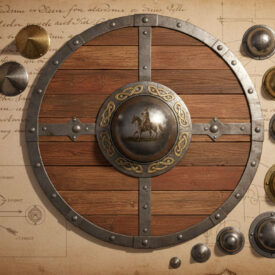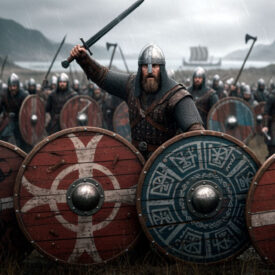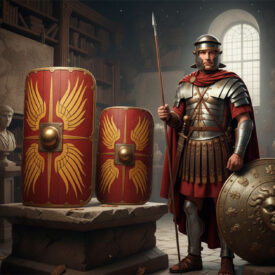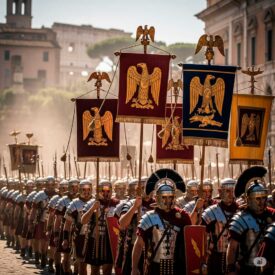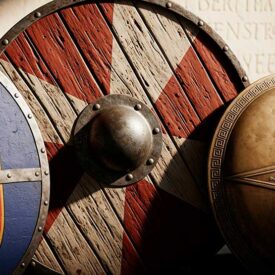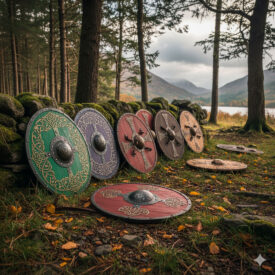What secret did the shield hold that turned Roman legionaries into the most feared force of antiquity? In a world where a soldier’s life hung by a thread, the Roman scutum was not just a piece of protection, but a companion in battle, a weapon, and an emblem of the discipline that forged an empire. Join us on this journey through the history, types, and tactical use of this legendary shield that defined the legions.
The Scutum: More Than a Shield, a Mobile Fortification
The scutum, employed by Roman heavy infantry, was a marvel of ancient military engineering. Its design, which adapted to the human body’s shape, offered formidable protection, not only deflecting projectiles but also defending against the impact of enemy swords. The breadth of these shields allowed legionaries to form a “shield wall,” an impenetrable barrier that protected them as they relentlessly advanced into combat or defended against sieges.
In addition to its defensive role, this shield was also a weapon in itself. At its center, the scutum housed a metallic umbo, a protrusion of iron or bronze that not only protected the legionary’s hand but was used to strike the enemy in the face or chest, causing severe injuries and even instantaneous death. It was an extension of the soldier’s will, combining defense and attack in a single gesture.
History and Evolution: From Clipeus to Imperial Scutum
The Roman scutum did not appear overnight; it was the result of centuries of adaptation and military evolution, reflecting Rome’s ability to learn and perfect its methods of warfare. Its roots lie in the Italic and Etruscan shields of the 4th century BC.
Origins and Precursors
- Clipeus: Initially, the Roman army, with phalanx formations inspired by Greek hoplites, used circular shields called Clipei.
- Samnite Influence: The adoption of a larger, rectangular shield, a precursor to the classical scutum, occurred after contact with the Samnites during the Samnite Wars.
- Tactical Reforms: After the Roman defeat to the Celts of Brennus in 387 BC, the consul Marcus Furius Camillus promoted reforms that led to the introduction of the scutum and the manipuli system.
Scutum Timeline: A Journey Through Time
| Era | Event |
|---|---|
| I. Origins and Influences (8th–4th centuries BC) | |
| 8th Century BC | A large elongated shield with reinforcement on its major axis appears in northern Italy; tendency towards an oval shape. |
| Roman Monarchy (753–509 BC) | Use of the clipeus: large, round shield (wood or wicker, reinforced with bronze sheet) by early Roman soldiers in phalanx formation, influenced by Greek models. |
| Late 5th Century BC | Introduction of a curved and enveloping (“tile-like”) surface, adopted by heavy legionary infantry and maintained until the Augustan era in certain models. |
| 4th Century BC | After contact with the Samnites (Samnite Wars), the Romans adopt a larger, rectangular shield, a direct precursor to the classical scutum. |
| II. Roman Republic (509 BC – 31 BC) | |
| 387 BC | After the defeat against the Celts of Brennus, Consul Marcus Furius Camillus initiates military reforms that lead to the eventual introduction of the scutum. |
| 315 BC | The triarii abandon the clipeus in favor of the scutum; the principes adopt the new shield shortly thereafter. |
| 2nd Century BC | Consolidation of the Republican scutum: oval and curved, with a central vertical protrusion (spina). Polybius offers a detailed description. Archaeological examples are dated between 274–100 BC. |
| Mid-Republic | Introduction and use of the parma (smaller round shield) by signifers (standard-bearers) and velites (light troops). |
| Late 1st Century BC (Civil War / Augustus) | Transition scuta: the elongated Italic shield undergoes cuts at the upper and lower ends and adopts a more rectangular and semi-cylindrical shape (Augustan scutum). |
| III. High Empire and “Tile-like” Shield (1st century BC – mid 3rd century AD) | |
| Last phase of Augustus (c. 9 AD) | Kalkriese scutum (Teutoburg): transitional model with less curvature (≈21.5 cm), without central spina and relatively light (≈5.2–5.5 kg). |
| First decades of the 1st Century AD | Generalization of the semi-cylindrical rectangular scutum (“tile-like”), which remains the predominant type in the legions until the second half of the 3rd century AD, although auxiliaries retain other models. |
| Late 1st Century AD – 2nd Century AD | Apogee of the rectangular and curved scutum; this model is widely represented in commemorative monuments (e.g., Trajan’s Column, 113 AD). |
| Mid-2nd Century AD | The presence of the rectangular scutum in monumental iconography begins to diminish, being replaced by curved oval-shaped shields. |
| 256 AD | Discovery in Dura Europos (Syria) of an almost complete rectangular scutum, a late example of this type found after the Sasanian siege (Tower 19). |
| Mid-3rd Century AD | End of the predominance of the rectangular scutum: the legions progressively abandon earlier models in favor of oval-shaped shields. |
| IV. Late Empire (3rd Century AD – 5th Century AD) | |
| Towards the end of the 3rd Century AD | Imposition of oval and flat shields with hemispherical umbones and flat base, favoring more mobile maneuvers and intertwined formations (e.g., synaspismós) during the crisis of the 3rd century. |
| 312 AD | After the Battle of Milvian Bridge, Constantine orders the Christian symbol (Greek letters Xi and Rho, Chi-Rho) to be painted on the shields. |
| 4th–5th Centuries AD | Predominance of large circular and flat shields; the rectangular scutum for closed formations disappears from general use. |
| End of the Western Empire | Progressive reduction in the size of shields, reflecting tactical changes and the influence of Germanic peoples on military practices. |
- Origins and Influences (8th–4th centuries BC)
-
- 8th Century BC: A large elongated shield with reinforcement on its major axis appears in northern Italy; tendency towards an oval shape.
- Roman Monarchy (753–509 BC): Use of the clipeus: large, round shield (wood or wicker, reinforced with bronze sheet) by early Roman soldiers in phalanx formation, influenced by Greek models.
- Late 5th Century BC: Introduction of a curved and enveloping (“tile-like”) surface, adopted by heavy legionary infantry and maintained until the Augustan era in certain models.
- 4th Century BC: After contact with the Samnites (Samnite Wars), the Romans adopt a larger, rectangular shield, a direct precursor to the classical scutum.
- Roman Republic (509 BC – 31 BC)
-
- 387 BC: After the defeat against the Celts of Brennus, Consul Marcus Furius Camillus initiates military reforms that lead to the eventual introduction of the scutum.
- 315 BC: The triarii abandon the clipeus in favor of the scutum; the principes adopt the new shield shortly thereafter.
- 2nd Century BC: Consolidation of the Republican scutum: oval and curved, with a central vertical protrusion (spina). Polybius offers a detailed description. Archaeological examples are dated between 274–100 BC.
- Mid-Republic: Introduction and use of the parma (smaller round shield) by signifers (standard-bearers) and velites (light troops).
- Late 1st Century BC (Civil War / Augustus): Transition scuta: the elongated Italic shield undergoes cuts at the upper and lower ends and adopts a more rectangular and semi-cylindrical shape (Augustan scutum).
- High Empire and “Tile-like” Shield (1st century BC – mid 3rd century AD)
-
- Last phase of Augustus (c. 9 AD): Kalkriese scutum (Teutoburg): transitional model with less curvature (≈21.5 cm), without central spina and relatively light (≈5.2–5.5 kg).
- First decades of the 1st Century AD: Generalization of the semi-cylindrical rectangular scutum (“tile-like”), which remains the predominant type in the legions until the second half of the 3rd century AD, although auxiliaries retain other models.
- Late 1st Century AD – 2nd Century AD: Apogee of the rectangular and curved scutum; this model is widely represented in commemorative monuments (e.g., Trajan’s Column, 113 AD).
- Mid-2nd Century AD: The presence of the rectangular scutum in monumental iconography begins to diminish, being replaced by curved oval-shaped shields.
- 256 AD: Discovery in Dura Europos (Syria) of an almost complete rectangular scutum, a late example of this type found after the Sasanian siege (Tower 19).
- Mid-3rd Century AD: End of the predominance of the rectangular scutum: the legions progressively abandon earlier models in favor of oval-shaped shields.
- Late Empire (3rd Century AD – 5th Century AD)
-
- Towards the end of the 3rd Century AD: Imposition of oval and flat shields with hemispherical umbones and flat base, favoring more mobile maneuvers and intertwined formations (e.g., synaspismós) during the crisis of the 3rd century.
- 312 AD: After the Battle of Milvian Bridge, Constantine orders the Christian symbol (Greek letters Xi and Rho, Chi-Rho) to be painted on the shields.
- 4th–5th Centuries AD: Predominance of large circular and flat shields; the rectangular scutum for closed formations disappears from general use.
- End of the Western Empire: Progressive reduction in the size of shields, reflecting tactical changes and the influence of Germanic peoples on military practices.
Morphological Evolution Throughout the Centuries
- Early and Middle Republic: Initially flatter and oval, it transformed into a curved and enveloping “tile-like” surface from the late 5th century BC. The oval and curved shield became dominant from the late 3rd century BC.
- Late Republic and Early Empire: It adopted its characteristic rectangular shape and pronounced curvature, with the upper and lower sides trimmed to create the semi-cylindrical design.
- Apogee of the Empire (1st-3rd centuries AD): The scutum reached its most recognized form: rectangular, curved, and with a reinforced central umbo. The Dura Europos Shield, from the 3rd century AD, is the best-preserved example.
- Late Empire (3rd-5th centuries AD): The rectangular scutum was gradually replaced by oval models, flatter and lighter, adapting to changing military tactics and Germanic influence.
Types of Scutum: The Diversity of Roman Protection
The scutum was not a monolithic design, but a family of shields that adapted to the specific needs of each Roman unit. The diversity of shapes and materials reflected the pragmatic vision of the Roman army.
| Shield Type | Period and Typical Use | Shape and Characteristics | Approximate Dimensions and Weight |
|---|---|---|---|
| Clipeus | Monarchy and early Republic | Round or oval, wood or wicker, reinforced with bronze. Useful for phalanx formation. | 90 cm diameter. |
| Republican Scutum | Middle and late Republic | Oval and convex/curved. Large size, covering from shoulder to knee. | 4 feet long (1.2 m), 2.5 feet wide. Weight: 7 to 10 kg. |
| Imperial Scutum | High Empire (1st-3rd centuries AD) | Rectangular, semi-cylindrical (tile-like shape), curved. Offered maximum protection. | Approximately 1.2 m high by 0.8 m wide. Weight: 7 to 10 kg. |
| Kalkriese Scutum | Augustan Era (c. 9 AD) | Intermediate model between the Republican and imperial tile-like, with slightly curved ends. | Height: 110 cm, Maximum width: 85 cm. Weight: 5.5 kg. |
| Late Imperial Scutum | Late Empire (3rd-5th centuries AD) | Oval or round, flatter and lighter. Used by mobile infantry (comitatenses). | Lighter than previous imperial models. |
- Clipeus
-
- Period and Typical Use: Monarchy and early Republic.
- Shape and Characteristics: Round or oval, wood or wicker, reinforced with bronze. Useful for phalanx formation.
- Approximate Dimensions and Weight: 90 cm diameter.
- Republican Scutum
-
- Period and Typical Use: Middle and late Republic.
- Shape and Characteristics: Oval and convex/curved. Large size, covering from shoulder to knee.
- Approximate Dimensions and Weight: 4 feet long (1.2 m), 2.5 feet wide. Weight: 7 to 10 kg.
- Imperial Scutum
-
- Period and Typical Use: High Empire (1st-3rd centuries AD).
- Shape and Characteristics: Rectangular, semi-cylindrical (tile-like shape), curved. Offered maximum protection.
- Approximate Dimensions and Weight: Approximately 1.2 m high by 0.8 m wide. Weight: 7 to 10 kg.
- Kalkriese Scutum
-
- Period and Typical Use: Augustan Era (c. 9 AD).
- Shape and Characteristics: Intermediate model between the Republican and imperial tile-like, with slightly curved ends.
- Approximate Dimensions and Weight: Height: 110 cm, Maximum width: 85 cm. Weight: 5.5 kg.
- Late Imperial Scutum
-
- Period and Typical Use: Late Empire (3rd-5th centuries AD).
- Shape and Characteristics: Oval or round, flatter and lighter. Used by mobile infantry (comitatenses).
- Approximate Dimensions and Weight: Lighter than previous imperial models.
Materials and Structure: Durability on the Battlefield

The scutum was made with a base of several layers of poplar or lime wood, joined with animal glue and with the grain in different directions for optimal resistance. Its outer surface was covered with linen or leather and painted with the distinctive designs of each unit.
- Reinforcements: The edges were reinforced with metal (iron or bronze) in most imperial models, although the scuta from Dura Europos and other late examples used leather for this purpose.
- Umbo: The central component was a metallic umbo (hemispherical or conical), crucial for deflecting blows and serving as an offensive weapon.
- Spina: In the Republican scutum, a central wooden rib, called spina, ran vertically across the shield, giving it consistency and widening for the grip.
- Grip: It was held with a single central horizontal handle, which facilitated its active use in hand-to-hand combat, unlike Greek shields.
The weight of the scutum varied, from 7-10 kg in the Republic to 5.5-7.5 kg in the Empire, reflecting improvements in materials and design, always seeking a balance between protection and maneuverability.
Beyond the Legionary Scutum: Parma and Other Shields
Not all Roman soldiers carried the imposing scutum. The Parma, a smaller, flat, and circular shield, was chosen by cavalry and light troops, such as the velites and auxiliaries, who needed greater mobility. Standard-bearers (signifers) also used the circular parma, and senior officers often carried the Parma Equestris as a parade weapon.
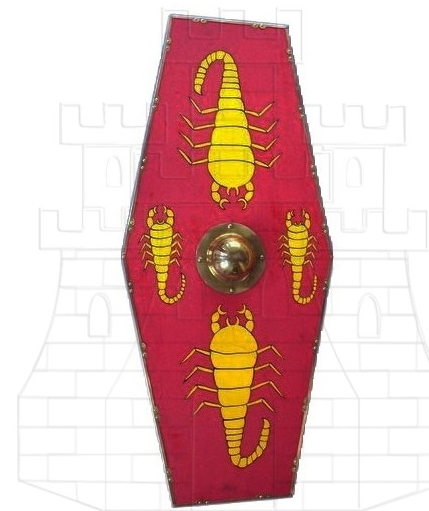
Tactical Use in the Legions: The Art of War with a Shield
The scutum was not merely a defensive element, but the central axis of Roman military tactics, a tool that transformed the legions into an unstoppable war machine.
Dual Function: Protection and Attack
- Defensive: Its size and curvature offered almost total coverage to the soldier, effectively protecting the left flank and deflecting projectiles, surpassing the Greek hoplon in flexibility.
- Offensive: It was an active combat tool. It was used to unbalance the enemy, creating openings for the fatal blow of the gladius or the spatha. The central umbo was crucial for pushing, unbalancing, or directly striking the adversary, transforming the shield into a blunt weapon beyond its primary function of protection.
The Unparalleled Testudo Formation: The Fortress of the Tortoises
The Testudo or “tortoise” is, perhaps, the most iconic formation associated with the scutum.
- Purpose: An impenetrable defensive formation, designed to protect legionaries from enemy projectiles during an advance under a rain of arrows or during a siege.
- Structure: Soldiers grouped closely with their scuta aligned shoulder to shoulder, held above their heads and overlapped like tiles, creating a virtually impreg nable shell. The side and rear shields were oriented horizontally to cover the flanks.
- Tactical Effectiveness: The semi-cylindrical design of the scutum allowed the shields to fit together perfectly, preventing slippage. This impenetrable barrier allowed the Romans to overcome palisades or walls of 2-3 meters, demonstrating astonishing tactical flexibility.
Identity and Cohesion on the Battlefield
The scutum was also a powerful symbol of identity for the legionary. Decorated with badges and distinctive colors of each military unit, Roman shields allowed recognition and fostered group cohesion. The soldier’s name, century, and legion to which he belonged were engraved on them. This detail, narrated by historians like Vegetius, underscores the importance of this shield not only as a tool of war, but as a vital element in the morale and spirit of an army.
Even in the decline of the Roman Empire, in the 4th century AD, the difficulty of gathering economic and professional resources led to the simplification of designs. The abandonment of discipline and the predominance of mercenary troops made the use of closed formations less viable, which led to the gradual replacement of the large rectangular shield by simpler and rounder shields, similar to the parma.
Clarifying doubts about the Roman scutum
What were the main differences between the Republican and Imperial scutum?
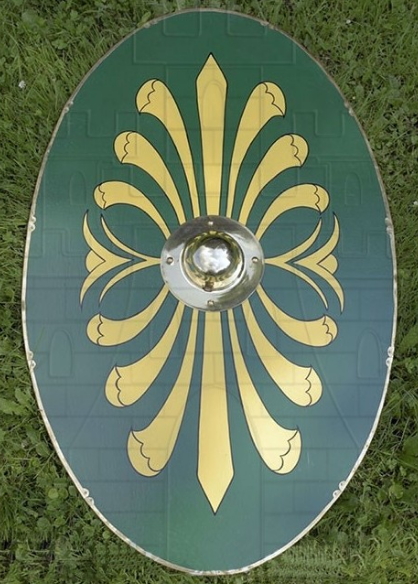
The main differences between the Republican and Imperial scutum can be summarized as follows:
- Shape and Design: The Republican scutum was more oval, while the Imperial one adopted a semi-cylindrical rectangular shape. The evolution during the Empire eliminated the central protrusion of the Republican scutum.
- Materials and Construction: The Imperial scutum was made of several layers of light and resistant wood, attached to a wooden or brass frame. In the Republic, the edge was lined with leather, while in the Empire, brass was used until the late Empire.
- Decoration: Republican scuta could have more varied decorations, while Imperial ones were more standardized in their design and decoration.
- Tactical Use: Although both were used for defensive formations, the design of the Imperial scutum allowed for greater effectiveness in the formation of mobile walls during the Empire.
How did the scutum’s design influence the combat tactics of the legionaries?
The design of the scutum, a large, curved, and rectangular shield, directly influenced the combat tactics of the legionaries by allowing compact and highly effective formations such as the testudo (tortoise formation), where shields overlapped to offer collective protection against projectiles and frontal attacks. Its large size covered from shoulder to knee, providing extensive defense and allowing soldiers to advance protected in a compact block.
Furthermore, the scutum’s curvature deflected blows and projectiles, while the central metallic umbo served as an offensive tool to push and stun the enemy before attacking with the gladius. The reinforced edges of the shield could also be used to strike, combining defense and attack in hand-to-hand combat. These characteristics made the scutum an essential element for tactical maneuverability, individual protection, and group coordination in the Roman army.
What materials were used to manufacture the scutum and how did they affect its durability?
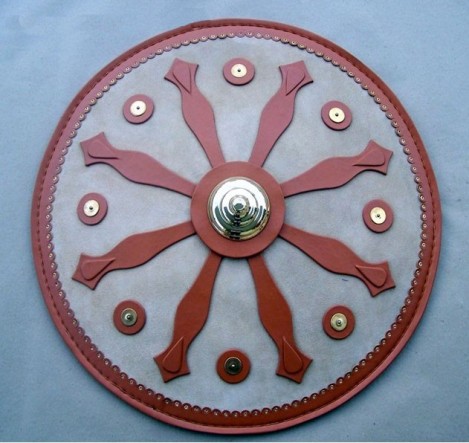
The Roman scutum was primarily made of several layers of wood joined by animal glue, usually light woods such as willow, poplar, lime, birch, elder, or alder, which were curved and glued to form a solid but not heavy structure. This wooden base was covered with leather or linen and sometimes a thin sheet of bronze or iron was applied to the edges to reinforce the structure. The shield had a metallic umbo of iron or a copper alloy in the center to protect the hand and serve as structural reinforcement.
This combination of materials made the scutum light enough for transport on long marches (between 5.5 and 7.5 kg) and at the same time resistant to blows and projectiles. The curvature and metallic lining helped to distribute and absorb impacts, increasing its durability and effectiveness in combat.
This combination of materials provided the scutum with adequate durability for intense use in warfare, combining protection with maneuverability.
How did the scutum evolve over the centuries and what factors motivated it?
The scutum evolved from an oval and curved shield in the Republic (3rd century BC) to a rectangular, concave, and more stylized model in the Roman Empire (1st to 2nd century AD). This rectangular design remained standard due to its effectiveness in closed formations, such as the famous “testudo” or tortoise formation, providing great protection and allowing collective defensive tactics. Its construction combined laminated wood, leather, and metal reinforcements, with a central umbo that also served as an offensive weapon.
From the 4th century AD onwards, due to the economic and organizational crisis of the Empire, there was a regression in the complexity and size of the scutum. The loss of discipline and the predominance of mercenary troops made the use of closed formations less viable, which led to the gradual replacement of the large rectangular shield by simpler and rounder shields, similar to the parma, which were easier to manufacture and use individually.
The motivating factors for this evolution were mainly:
- Adaptation to changing military tactics, moving from more open combat to dense formations and vice versa.
- Technological innovations and materials to optimize weight, resistance, and functionality.
- Socio-economic and organizational changes in the Roman army, especially after the crisis of the 3rd century, which limited resources and discipline.
Thus, the scutum evolved into simpler forms in the late period, adapting to new tactics and the Empire’s limitations.
What role did the umbo play in the tactical use of the scutum?
The umbo in the Roman scutum served a dual function: defensive and offensive. On the one hand, it reinforced the center of the shield and protected the legionary’s hand from direct impacts. On the other hand, it was an offensive contact tool: soldiers used it to push, strike, and destabilize the enemy, creating openings that facilitated their next attack with the gladius. Thus, the umbo transformed the shield into an active weapon, allowing the opponent to be unbalanced and the initiative to be maintained in hand-to-hand combat.
The Roman scutum was much more than a simple shield; it was a banner of Rome’s ingenuity, discipline, and military might. From its humble origins to becoming the symbol of the invincible legion, this shield protected the men who forged an empire, demonstrating that true strength lies both in unyielding defense and cunning attack. Every scutum replica you can find today is an echo of that greatness, a window into an era where steel and skill decided the fate of the world.

